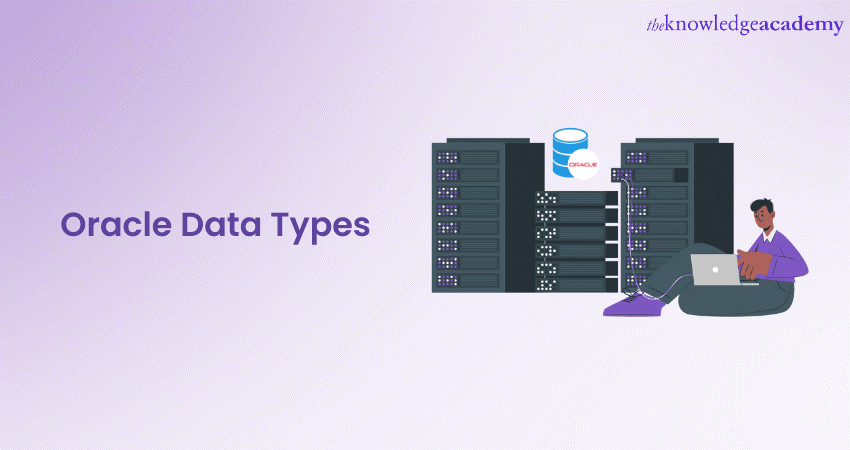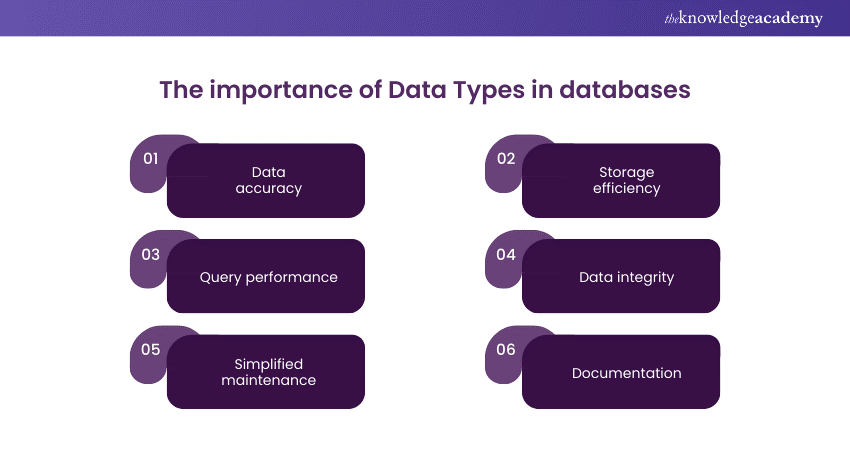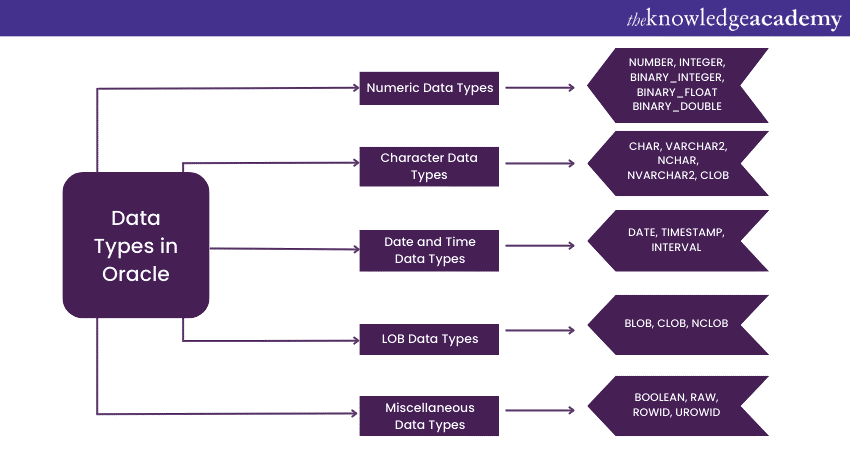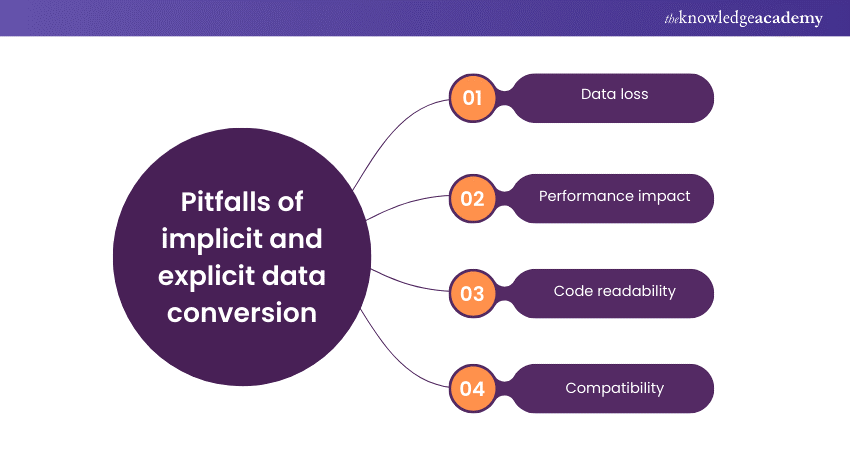We may not have the course you’re looking for. If you enquire or give us a call on 01344203999 and speak to our training experts, we may still be able to help with your training requirements.
Training Outcomes Within Your Budget!
We ensure quality, budget-alignment, and timely delivery by our expert instructors.

Oracle Database is one of the most popular and widely used Relational Database Management Systems (RDBMS) in the world. At the heart of this database system are Oracle Data Types. It is a fundamental concept that defines how data can be stored in a database.
According to Statista, Oracle is the most popular Database Management System in the world. So, understanding its concepts like Data Types and how it operates can go a long way in getting a high-paying job. That’s what this blog is all about. In this blog, we will take a deep dive into Oracle Data Types, exploring their significance, classification, and usage within the Oracle Database ecosystem.
Table of Contents
1) Understanding Data Types in Oracle
2) The importance of Data Types in Databases
3) How to select the right Data Type?
4) Built-in Data Types in Oracle
5) User-Defined Data Types (UDTs)
6) Implicit and explicit data conversion
7) Conclusion
Understanding Data Types in Oracle
Data Types in Oracle refer to the categorisation of data based on its nature, characteristics, and storage requirements. At its core, a Data Type defines the nature of information that can be housed in a column or variable. This classification system not only provides a logical framework for organising diverse data but also ensures data integrity and optimised performance.
In the context of Oracle, comprehending Data Types is imperative due to their role in data validation. By specifying the type of data that can be stored in a column, Oracle ensures that only valid and consistent information is entered, thus enhancing data quality. Furthermore, Data Types influence storage requirements, as different Data Types demand varying amounts of space for storage, directly affecting database performance.
Oracle Database supports an array of Data Types catering to different data categories, such as numeric, character, date and time, and large objects. This versatility empowers Database Administrators to choose the most appropriate type for each data scenario, striking a balance between precision and efficiency. As businesses deal with increasingly complex data, a profound understanding of Oracle Data Types becomes pivotal for constructing robust databases that maintain data integrity while optimising storage and retrieval operations.
Don't miss our Handpicked Oracle Interview Questions and Answers from our Expert team to crack Interviews Easily.
The importance of Data Types in databases
Data Types are vital in Database Management Systems (DBMS) due to their profound impact on data accuracy and operational efficiency. Here's why they are so important:

1) Data accuracy: Data Types dictate the acceptable format for each database column, enforcing data uniformity. By upholding data consistency, they minimise errors and enhance data integrity, preventing the storage of inconsistent or erroneous information.
2) Storage efficiency: Varying Data Types requires different storage spaces. Properly selected Data Types optimise storage use, which is especially crucial in large-scale databases where efficient storage management reduces costs and boosts performance.
3) Query performance: Data Types directly influence query speed. When DBMS understands Data Types, it uses specialised algorithms for quicker query execution, improving system efficiency.
4) Data integrity: Data Types act as guards against data corruption. They restrict data entries to conform to column requirements, ensuring reliability and consistency. For example, a DATE Data Type prevents non-date values.
5) Simplified maintenance: Clear Data Types simplify Database Management. They aid administrators and developers in data storage, indexing, and query optimisation decisions, streamlining tasks like data migration and system upgrades.
6) Documentation: Data Types inherently document the database schema, helping developers understand data column characteristics for effective query and report creation.
Overall, Data Types are foundational for data integrity, storage efficiency, and query performance within DBMS. They guarantee proper data storage, processing, and accurate reporting while streamlining Database Management. Careful Data Type selection and management are essential in database design and maintenance.
How to select the right Data Type?
Choosing the right Data Type is crucial for database design. Let's explore the criteria for selecting the right Data Type:
1) Nature of the data: Analyse the type and format of the data, whether numeric, alphanumeric, date, time, or binary.
2) Size of the data: Evaluate the data's range and precision to determine the necessary digits or characters.
3) Performance needs: Assess the speed and efficiency required for database operations, including insertion, retrieval, updates, and deletions.
4) Portability requirements: Consider data compatibility and interoperability across platforms, addressing export, import, and conversion.
5) Future data use: Anticipate potential changes or enhancements, allowing for data extension, modification, or aggregation planning.
These factors play a pivotal role in selecting the right Data Type. They help ensure that your database efficiently stores and processes information while accommodating future needs.
Built-in Data Types in Oracle
Oracle offers a rich assortment of built-in Data Types, each tailored to accommodate different types of data, ensuring optimal storage efficiency and integrity. These built-in Data Types are grouped into various categories, including numeric, character, date and time, Large Objects (LOB), and miscellaneous types. Let's explore each of these categories in detail.

1) Numeric Data Types:
Numeric Data Types form the foundation for storing numerical values, ranging from whole numbers to fractional values. Oracle provides a variety of numeric Data Types, each designed to meet different precision and storage requirements.
a) NUMBER: The versatile NUMBER Data Type supports both integer and floating-point numbers. It offers exceptional flexibility by allowing users to define the precision and scale of the stored value. Precision determines the total number of digits in the number, while scale represents the number of decimal places.
b) INTEGER: This Data Type is ideal for storing whole numbers without decimal points. INTEGER Data Type supports positive and negative integers, providing efficient storage for numerical values that don't require fractional parts.
c) BINARY_INTEGER: Similar to INTEGER, the BINARY_INTEGER Data Type stores whole numbers. It is often used for arithmetic calculations and is more memory-efficient than NUMBER or INTEGER Data Types.
d) BINARY_FLOAT: BINARY_FLOAT is a single-precision floating-point number Data Type, typically used for scientific calculations or where precision beyond a certain point is not critical.
d) BINARY_DOUBLE: BINARY_DOUBLE is a double-precision floating-point number Data Type, offering higher precision compared to BINARY_FLOAT. It is ideal for scenarios where precision is crucial, such as financial calculations.
2) Character Data Types:
Character Data Types are pivotal for storing textual information, from single characters to lengthy strings of text. These Data Types offer the foundation for handling linguistic content and textual data.
a) CHAR: The CHAR Data Type stores fixed-length character strings. It is often used for storing data with consistent lengths, such as codes or abbreviations.
b) VARCHAR2: Unlike CHAR, the VARCHAR2 Data Type stores variable-length character strings. It is a popular choice for storing textual data of varying lengths, optimising storage space.
c) NCHAR: NCHAR is used to store fixed-length Unicode character strings, making it suitable for multilingual data storage. Just like CHAR, NCHAR pads values to the specified length, ensuring uniformity in storage.
d) NVARCHAR2: Similar to VARCHAR2, NVARCHAR2 is designed for variable-length Unicode character strings. It accommodates different language scripts, ensuring accurate representation and storage of diverse textual content.
e) CLOB: For storing extensive amounts of character data, the CLOB Data Type is employed. It can accommodate large volumes of text, making it suitable for articles, documents, and other text-heavy content.
3) Date and Time Data Types:
Date and time Data Types are crucial for accurately representing temporal information within databases. Oracle provides several Data Types tailored to capture different aspects of time
a) DATE: The DATE Data Type is used to store date and time information, down to the second. It includes day, month, year, hours, minutes, and seconds.
b) TIMESTAMP: The TIMESTAMP Data Type enhances the DATE Data Type by offering higher precision, including fractional seconds. It's useful for scenarios where precise time intervals must be maintained.
c) INTERVAL: The INTERVAL Data Type facilitates the storage of time intervals, enabling calculations involving days, hours, minutes, and seconds.
4) LOB Data Types:
LOB Data Types are instrumental for managing and storing large binary or character data, such as images, audio files, and videos.
a) BLOB: The BLOB Data Type is designed for binary large objects, accommodating various forms of binary data, including images, videos, and application files.
b) CLOB: As mentioned earlier, the CLOB Data Type primarily focuses on storing character large objects, supporting extensive textual content.
c) NCLOB: National Character Large Object or NCLOB is a variation of CLOB that is designed to handle character data in a specific character set, such as Unicode. This is especially important for applications with international users and diverse language requirements.
5) Miscellaneous Data Types
Oracle's diverse offerings extend beyond the fundamental categories, including additional Data Types to address specific requirements.
a) BOOLEAN: The BOOLEAN Data Type in Oracle represents a two-valued logic – TRUE or FALSE. While not as native as in programming languages like Java or Python, BOOLEAN is often used in PL/SQL procedures and functions to make conditional decisions. It offers simplicity and clarity, enhancing the readability of code segments that involve logical evaluations.
b) RAW: The RAW Data Type is designed to store binary data, making it suitable for situations where data needs to be stored exactly as it is, without any character set conversion. This is particularly valuable for applications involving encryption, hashing, and binary data manipulation. The size of a RAW column is specified in bytes, offering a flexible way to accommodate varying binary data lengths.
c) ROWID: ROWID is a Data Type that uniquely identifies a row within a database table. It is often used internally by the database engine for optimising queries and data manipulation operations. While ROWID can be useful for certain advanced scenarios, it's essential to use it cautiously, as its value might change during database operations like table reorganisations.
d) UROWID: The UROWID Data Type, standing for "universal row identifier," is like ROWID but provides more flexibility in a distributed database environment. It can uniquely identify rows across multiple databases, making it useful in scenarios involving database links and distributed transactions.
Unlock the power of Data Management with the Oracle Database 12c Administration Course – Join Today!
User-Defined Data Types (UDTs)
Oracle Database's versatility extends beyond its built-in Data Types. With the capability to create User-Defined Data Types, Oracle offers a powerful tool for tailoring Data Management to specific business needs. Let's explore the concept of UDTs, their benefits, and how they empower organisations to enhance data organisation and application efficiency.
Creating custom Data Types:
User-Defined Data Types enable Database Administrators and Developers to design specialised data structures that encapsulate multiple attributes. This encapsulation simplifies the data model, making it more intuitive and consistent. By combining attributes into a single UDT, data integrity is improved, as users are guided towards maintaining a uniform structure.
Benefits and use cases:
The benefits of UDTs are multiple. Firstly, they enhance code readability and reusability. Instead of managing individual attributes scattered across the database schema, developers can work with well-defined, high-level data structures. This promotes efficient code maintenance and reduces the chances of errors.
Secondly, UDTs are particularly beneficial in modelling complex real-world entities. Consider an example where you need to represent a 'Customer' entity with attributes like name, address, contact information, and purchase history. Instead of dealing with separate columns, a 'Customer' UDT encapsulates all these attributes, making it easier to manage, query, and update customer data.
Furthermore, UDTs can improve data consistency. For instance, when you have multiple tables storing addresses, defining a common 'Address' UDT ensures uniform formatting and validation rules, thus avoiding data discrepancies.
UDTs also play a pivotal role in data security. By abstracting sensitive information within a UDT, access can be controlled more effectively. This adds a layer of confidentiality, limiting exposure to certain data.
Implementation and considerations
Creating a UDT involves defining its structure, specifying attributes, and assigning appropriate Data Types. Once defined, UDTs can be used as column Data Types in tables, facilitating seamless integration into the existing data model.
However, careful consideration is essential when implementing UDTs. Overuse of UDTs can lead to an overly complex schema, adversely affecting maintainability. Moreover, UDTs should be designed with future scalability in mind, accommodating potential changes to the data structure without causing extensive modifications.
Master the basics of SQL with our Oracle SQL Fundamentals Course – Sign up now!
Implicit and explicit data conversion
In Oracle Databases, the ability to smoothly handle data of diverse types is paramount. Oracle, being a powerful and versatile relational Database Management System, offers two methods for managing data conversion: implicit and explicit data conversion. These mechanisms are crucial for maintaining data integrity, ensuring accuracy, and facilitating seamless data manipulation.
Implicit data conversion
Implicit data conversion, also known as automatic data conversion, occurs when Oracle automatically converts data from one type to another during various operations, such as inserting, updating, or retrieving data. This process is particularly useful when data of one type needs to be used in a context that expects a different type. For example, if you attempt to add an INTEGER to a FLOAT column, Oracle will automatically convert the INTEGER value to FLOAT before performing the operation.
Implicit data conversion works well when the Data Type conversion is straightforward and unambiguous. Oracle's built-in rules dictate how certain Data Types can be converted implicitly. However, relying solely on implicit conversion might lead to unintended results or performance issues, especially in complex scenarios.
Explicit data conversion
Explicit data conversion, on the other hand, involves the intentional and controlled conversion of data from one type to another using specific functions provided by Oracle. This approach offers more transparency and control over the conversion process, ensuring that data is transformed precisely as intended. Oracle provides a range of functions, such as TO_NUMBER, TO_DATE, and TO_CHAR, which allow developers to convert data explicitly between different Data Types.
The explicit data conversion process requires specifying the source Data Type and the target Data Type in the conversion function. This precision is particularly beneficial when dealing with Data Types that don't have a direct or automatic conversion relationship. For instance, converting a string representation of a date to an actual DATE Data Type can be executed accurately using explicit conversion functions.
Considerations and pitfalls
While both implicit and explicit data conversion have their merits, it's essential to be aware of their potential pitfalls:

a) Data loss: In implicit conversion, there's a risk of data loss if the conversion results in a loss of precision or magnitude. Explicit conversion provides more control, reducing the likelihood of data loss.
b) Performance impact: Implicit conversion can impact performance, especially when applied to large datasets or complex queries. Explicit conversion allows developers to optimise conversions based on the context.
c) Code readability: Explicit conversion functions enhance code readability by making Data Type transformations more explicit and understandable.
d) Compatibility: When working with data from external sources or different databases, explicit conversion ensures compatibility by explicitly defining the Data Type transformation.
Both implicit and explicit data conversion are valuable tools within the Oracle ecosystem. Implicit conversion offers convenience in straightforward scenarios, allowing Oracle to handle Data Type conversions seamlessly. Explicit conversion, on the other hand, grants the Developer control and precision over conversions, ensuring accuracy and enhancing code readability. By understanding the differences and implications of these two methods, database professionals can make informed choices when manipulating data and designing robust applications within the Oracle database environment.
Conclusion
In this comprehensive overview, we have delved into the world of Oracle Data Types, understanding their significance, classifications, and applications. With the knowledge gained, you are better equipped to make informed decisions when designing, implementing, and managing databases within the Oracle ecosystem. As data continues to grow in complexity and volume, mastering the art of Data Type selection and utilisation remains a cornerstone of successful Database Management in the ever-evolving digital landscape.
Elevate your skills with comprehensive Oracle Training and unlock new opportunities in the world of Database Management.
Frequently Asked Questions

Changing the Data Type of a column in an existing Oracle Database can be a complex process and may require data migration and potential downtime. It's essential to carefully plan and execute such changes to avoid data loss or disruptions. Our blog discusses best practices for handling Data Type changes in Oracle Databases.

No, Oracle Data Types are specific to the Oracle Database system and may vary from Data Types used in other Database Management Systems. It's essential to be familiar with Oracle's Data Type system when working with Oracle Databases to ensure proper data handling and compatibility.

The Knowledge Academy takes global learning to new heights, offering over 30,000 online courses across 490+ locations in 220 countries. This expansive reach ensures accessibility and convenience for learners worldwide.
Alongside our diverse Online Course Catalogue, encompassing 17 major categories, we go the extra mile by providing a plethora of free educational Online Resources like News updates, Blogs, videos, webinars, and interview questions. By tailoring learning experiences further, professionals can maximise value with customisable Course Bundles of TKA.

The Knowledge Academy’s Knowledge Pass, a prepaid voucher, adds another layer of flexibility, allowing course bookings over a 12-month period. Join us on a journey where education knows no bounds.

The Knowledge Academy offers various Oracle Courses, including Oracle SQL Fundamentals, Oracle Database 12c: Administration and Oracle Accounts Payable Training. These courses cater to different skill levels, providing comprehensive insights into IT Infrastructure & Networking methodologies.
Our IT Infrastructure & Networking blogs cover a range of topics related to Oracle, offering valuable resources, best practices, and industry insights. Whether you are a beginner or looking to advance your Database Management skills, The Knowledge Academy's diverse courses and informative blogs have you covered.
Upcoming Programming & DevOps Resources Batches & Dates
Date
 Oracle Database 12c: Administration
Oracle Database 12c: Administration
Mon 3rd Jun 2024
Mon 2nd Sep 2024
Mon 2nd Dec 2024







 Top Rated Course
Top Rated Course



 If you wish to make any changes to your course, please
If you wish to make any changes to your course, please


